Jul 23, 2020 This is one of my favorite weeknight meals and comes together rather quickly.
If there’s one dish that I eat at every Thai restaurant, then it’s this- Pad Thai along with the Thai fried rice maybe. However more often that not, I am left disappointed with the vegan pad thai that most restaurants serve. I think mostly I am not a fan of the sauce. There are few places though including a local Thai place who make amazing vegan pad thai, so whenever I have a craving, we would just drive to that place. But with how things are in the world right now, dining in is not an option (not for now at least). So, few days back when I had the pad thai craving, I knew I had to make it at home. I have made these noodles several times at home but never really used the right type of noodles. Mostly I would just use spaghetti because that’s what I had on hand. But this time around, I ordered all the grocery and made the real deal. I can’t claim it to be authentic (because I am not Thai!) but I can guarantee that it tastes like a good pad thai from your favorite Thai restaurant!
What is Pad Thai
Pad Thai is a stir-fry rice noodle dish served as a street food in Thailand. It is extremely popular not only in Thailand but world over. The first time I had pad thai was many years ago at a local Thai restaurant. And since then it’s go to-dish whenever we eat at a Thai place. Making this dish at home is not difficult. But you do need the right ingredients for that authentic taste. Here are few things in my opinion are essential good a good pad thai. Choose the right noodles- starting with the noodles of course, make sure you choose the right type of noodles for this dish. Pad thai is made with flat rice noodles. I use medium width rice stick noodles which works very well for this recipe. You can choose any wide rice noodles here. For the pad thai recipe, these rice stick noodles only need to be soaked in hot water for around 8 minutes, then drained and added to the stir-fry.
Right ingredients for the sauce- the flavor of pad thai depends on the sauce so the ingredients have to be correct. This sauce has three main ingredients: tamarind, soy sauce and brown sugar. The sourness in pad thai comes from Tamarind. You have to use it for that authentic flavor. I always have a jar of tamarind concentrate in the fridge because I use it in sambar often. Traditionally for sambar and also for pad thai, the tamarind block has to be soaked and then the juice has to extracted. But, I feel the tamarind concentrate works well and saves me time. You will be find it at any Indian grocery or Asian grocery store. Sure, you will find recipes using vinegar but for that authentic flavor, don’t skip on the tamarind. If you have whole tamarind block, soak a small block in hot water for around 20 minutes, then extract the thick juice using a strainer and use that in the recipe. The second key ingredient in the sauce is fish sauce but since I am a vegetarian, I just use more of the soy sauce. If you want to add more depth of flavors, you can add some vegetarian oyster sauce. I did not add it. Other essential ingredients- so, the other ingredients which you need for that authentic taste are bean sprouts, tofu and garlic chives. You can find these at any Asian grocery store. If you can’t find garlic chives, use green onions. Garnishes are important- a pad thai is incomplete without those crushed peanuts and lime wedges. Do not skip on these! I also like to serve mine with a bowl of hot chili sauce. It’s a must in my opinion.
Method
1- Add rice stick noodles to a large pot and then pour boiling water over the noodles. Soak noodles in boiling water for 8 minutes. 2- Then drain the water and rinse the noodles under cold water and set aside. I also cut the noodles sometimes with a scissor so that it’s easier to toss the noodles with the sauce and veggies later. I followed the instructions for the rice stick noodles that I used, if using any other noodle type, follow the instructions on the package. 3- To a measuring jar or bowl, add all the ingredients for the sauce- tamarind concentrate, soy sauce, brown sugar and 1 tablespoon water. Mix well and set aside. 4- Press the tofu with a heavy object for around 20 minutes, do this before you soak the noodles. Then cut into small cubes and toss the tofu with cornstarch until coated.
5- Heat 1 tablespoon oil in a skillet on medium heat. Once hot, add the cornstarch tossed tofu to the pan in a single layer. Cook for around 7 minutes on one side until it turns golden brown in color. Then flip and cook the other side. Remove the cooked tofu on a plate. 6- To a wok, now add the remaining 2 tablespoons of oil on medium-high heat. Once hot, add the chopped garlic, sliced onion, thai chili and cook for 2 minutes. 7- Then add the sliced carrot and peppers and cook for 2 more minutes. 8- Add the bean sprouts and mix.
9- Add in the prepared sauce 10- Followed by the noodles. Mix well until everything is well combined, I use a pair of tongs to mix everything together. 11- Cook for around 3 minutes until all of the sauce is absorbed by the noodles. Then add garlic chives. 12- Also add salt and red chili flakes, mix and turn off the heat.
Place this Vegan Pad Thai on serving plate and garnish with lots of crushed peanuts and serve with lime wedge and a side of hot sauce.
If you’ve tried this Vegan Pad Thai Recipe then don’t forget to rate the recipe! You can also follow me on Facebook, Instagram to see what’s latest in my kitchen!
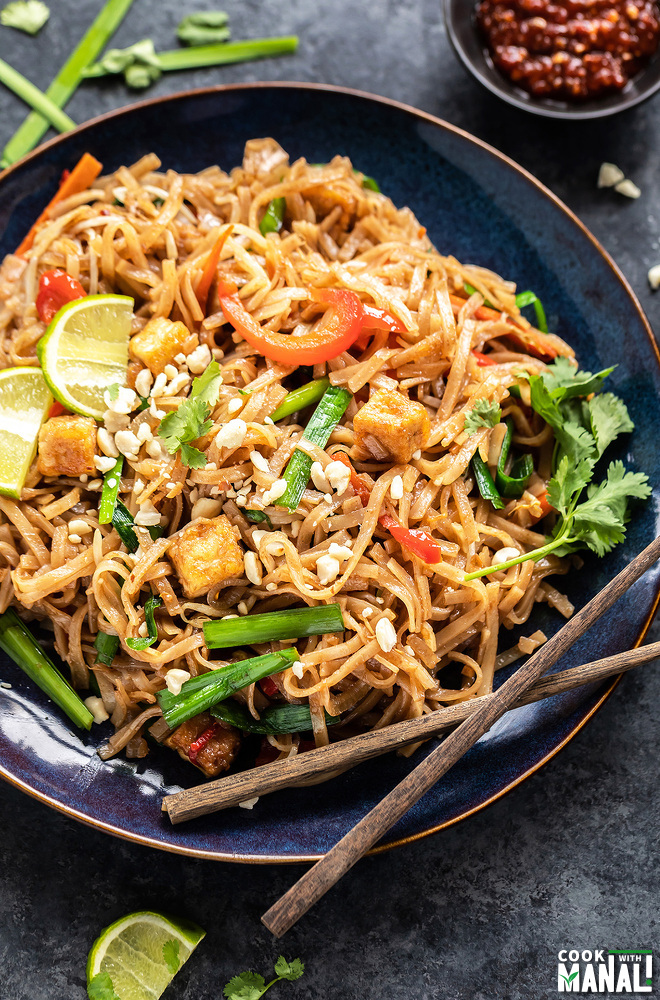
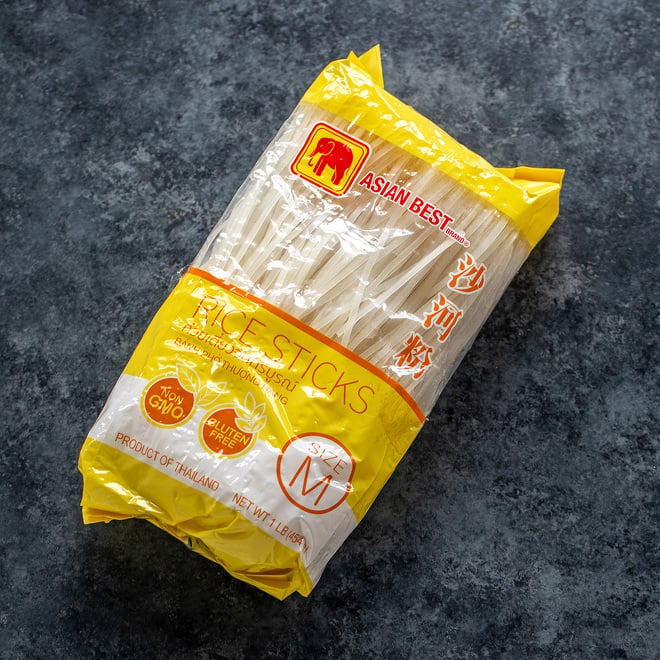
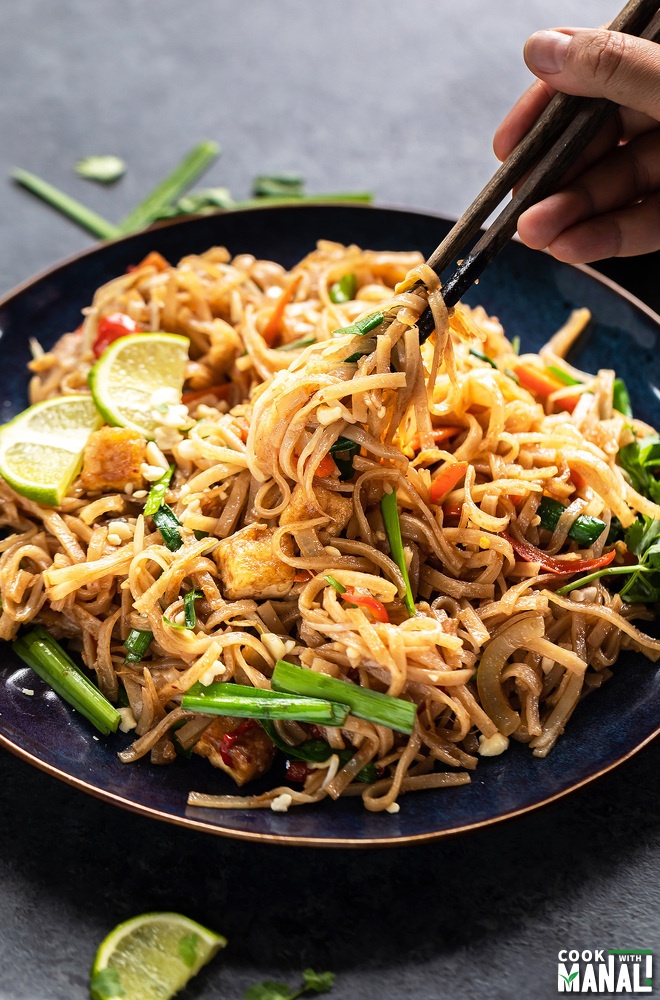
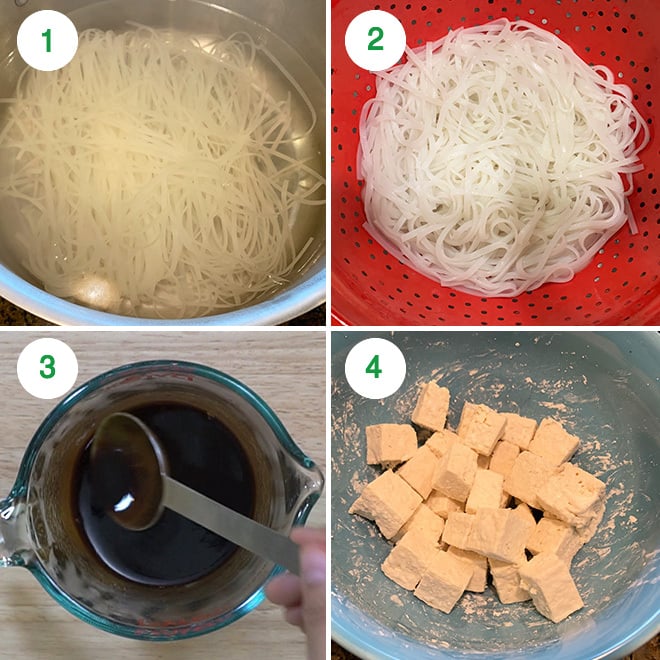
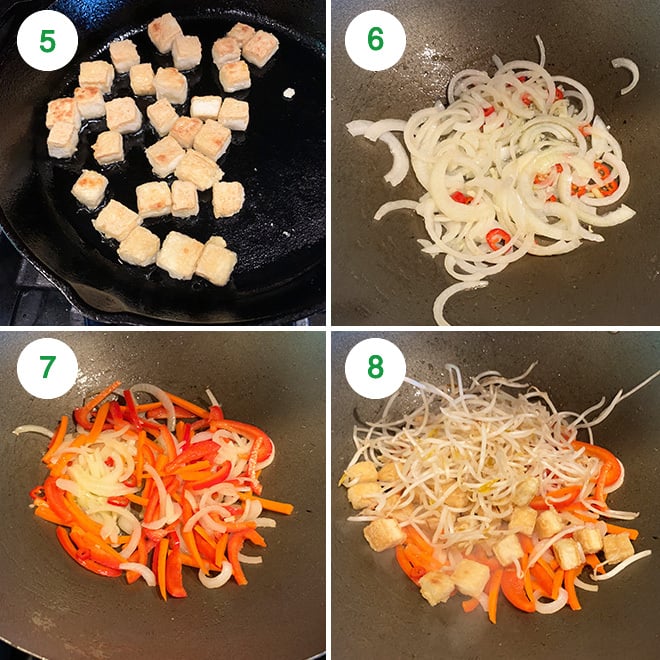
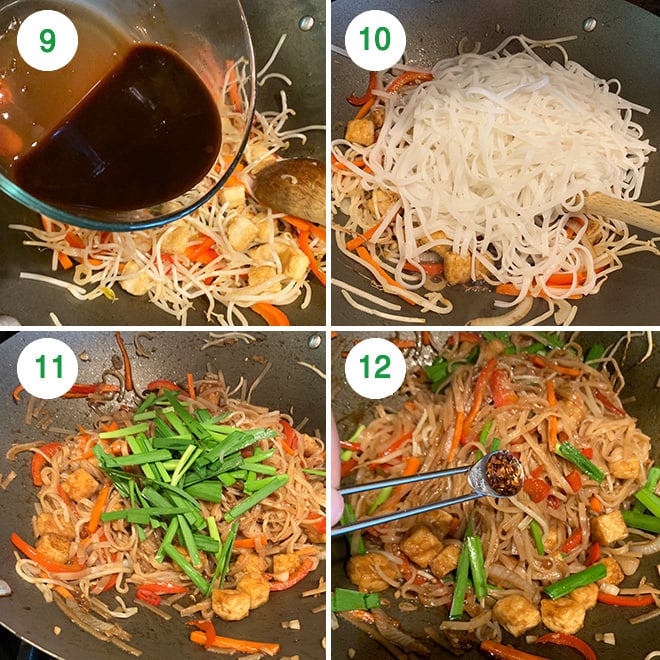
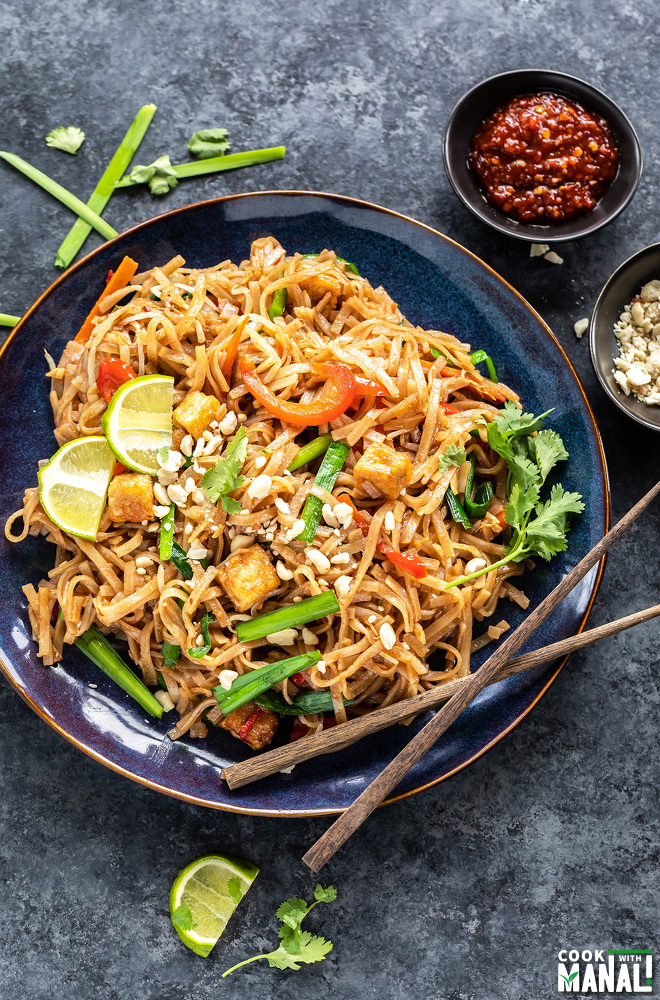
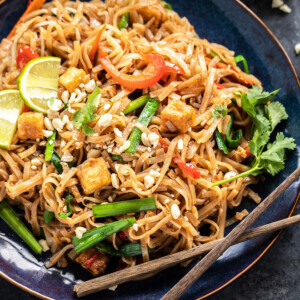
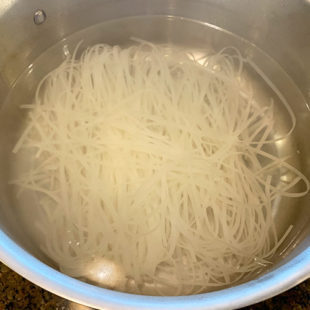
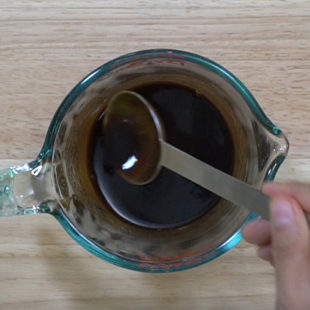
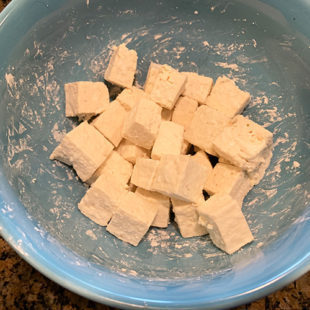
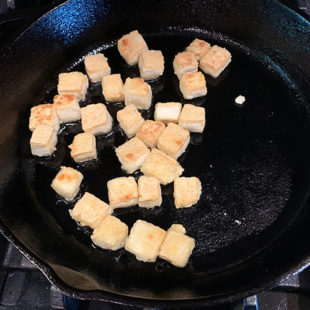

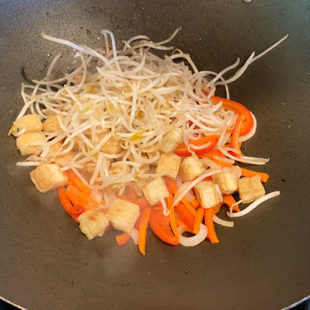
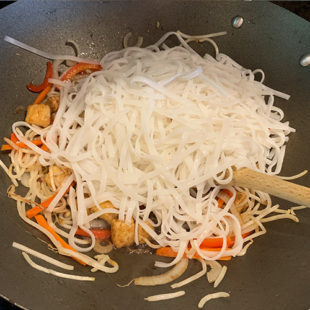
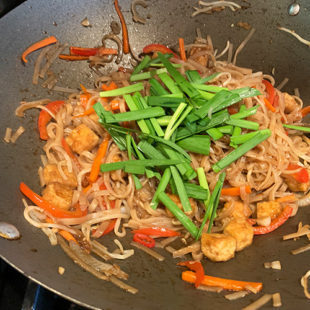
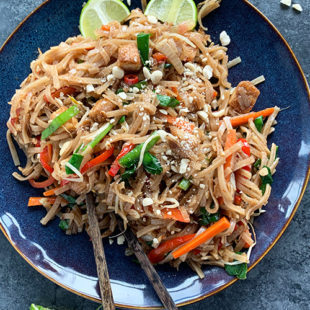
title: “Vegan Pad Thai " ShowToc: true date: “2024-10-06” author: “Ida Wakefield”
Jul 23, 2020 This is one of my favorite weeknight meals and comes together rather quickly.
If there’s one dish that I eat at every Thai restaurant, then it’s this- Pad Thai along with the Thai fried rice maybe. However more often that not, I am left disappointed with the vegan pad thai that most restaurants serve. I think mostly I am not a fan of the sauce. There are few places though including a local Thai place who make amazing vegan pad thai, so whenever I have a craving, we would just drive to that place. But with how things are in the world right now, dining in is not an option (not for now at least). So, few days back when I had the pad thai craving, I knew I had to make it at home. I have made these noodles several times at home but never really used the right type of noodles. Mostly I would just use spaghetti because that’s what I had on hand. But this time around, I ordered all the grocery and made the real deal. I can’t claim it to be authentic (because I am not Thai!) but I can guarantee that it tastes like a good pad thai from your favorite Thai restaurant!
What is Pad Thai
Pad Thai is a stir-fry rice noodle dish served as a street food in Thailand. It is extremely popular not only in Thailand but world over. The first time I had pad thai was many years ago at a local Thai restaurant. And since then it’s go to-dish whenever we eat at a Thai place. Making this dish at home is not difficult. But you do need the right ingredients for that authentic taste. Here are few things in my opinion are essential good a good pad thai. Choose the right noodles- starting with the noodles of course, make sure you choose the right type of noodles for this dish. Pad thai is made with flat rice noodles. I use medium width rice stick noodles which works very well for this recipe. You can choose any wide rice noodles here. For the pad thai recipe, these rice stick noodles only need to be soaked in hot water for around 8 minutes, then drained and added to the stir-fry.
Right ingredients for the sauce- the flavor of pad thai depends on the sauce so the ingredients have to be correct. This sauce has three main ingredients: tamarind, soy sauce and brown sugar. The sourness in pad thai comes from Tamarind. You have to use it for that authentic flavor. I always have a jar of tamarind concentrate in the fridge because I use it in sambar often. Traditionally for sambar and also for pad thai, the tamarind block has to be soaked and then the juice has to extracted. But, I feel the tamarind concentrate works well and saves me time. You will be find it at any Indian grocery or Asian grocery store. Sure, you will find recipes using vinegar but for that authentic flavor, don’t skip on the tamarind. If you have whole tamarind block, soak a small block in hot water for around 20 minutes, then extract the thick juice using a strainer and use that in the recipe. The second key ingredient in the sauce is fish sauce but since I am a vegetarian, I just use more of the soy sauce. If you want to add more depth of flavors, you can add some vegetarian oyster sauce. I did not add it. Other essential ingredients- so, the other ingredients which you need for that authentic taste are bean sprouts, tofu and garlic chives. You can find these at any Asian grocery store. If you can’t find garlic chives, use green onions. Garnishes are important- a pad thai is incomplete without those crushed peanuts and lime wedges. Do not skip on these! I also like to serve mine with a bowl of hot chili sauce. It’s a must in my opinion.
Method
1- Add rice stick noodles to a large pot and then pour boiling water over the noodles. Soak noodles in boiling water for 8 minutes. 2- Then drain the water and rinse the noodles under cold water and set aside. I also cut the noodles sometimes with a scissor so that it’s easier to toss the noodles with the sauce and veggies later. I followed the instructions for the rice stick noodles that I used, if using any other noodle type, follow the instructions on the package. 3- To a measuring jar or bowl, add all the ingredients for the sauce- tamarind concentrate, soy sauce, brown sugar and 1 tablespoon water. Mix well and set aside. 4- Press the tofu with a heavy object for around 20 minutes, do this before you soak the noodles. Then cut into small cubes and toss the tofu with cornstarch until coated.
5- Heat 1 tablespoon oil in a skillet on medium heat. Once hot, add the cornstarch tossed tofu to the pan in a single layer. Cook for around 7 minutes on one side until it turns golden brown in color. Then flip and cook the other side. Remove the cooked tofu on a plate. 6- To a wok, now add the remaining 2 tablespoons of oil on medium-high heat. Once hot, add the chopped garlic, sliced onion, thai chili and cook for 2 minutes. 7- Then add the sliced carrot and peppers and cook for 2 more minutes. 8- Add the bean sprouts and mix.
9- Add in the prepared sauce 10- Followed by the noodles. Mix well until everything is well combined, I use a pair of tongs to mix everything together. 11- Cook for around 3 minutes until all of the sauce is absorbed by the noodles. Then add garlic chives. 12- Also add salt and red chili flakes, mix and turn off the heat.
Place this Vegan Pad Thai on serving plate and garnish with lots of crushed peanuts and serve with lime wedge and a side of hot sauce.
If you’ve tried this Vegan Pad Thai Recipe then don’t forget to rate the recipe! You can also follow me on Facebook, Instagram to see what’s latest in my kitchen!
















